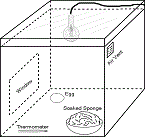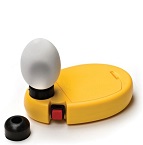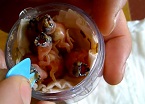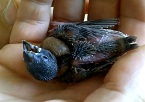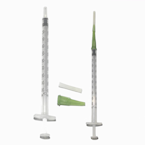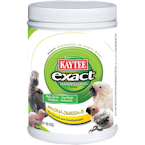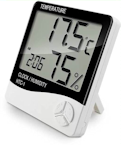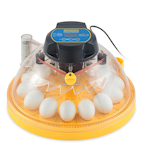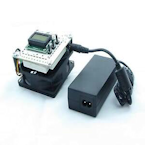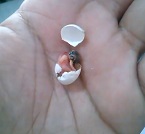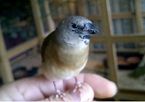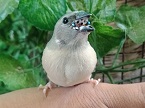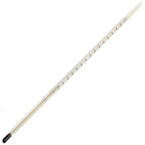Hand Rearing
I have been involved in countless conversations concerning the topic of hand rearing, and it is an interesting topic for discussion. The first thing that comes to mind when talking about or offering advice on hand rearing is the reason behind why they would need or want to hand rear. Sometimes eggs or chicks are abandoned, you may need to hand feed a sick bird, or maybe you just want to rear a chick to be a friendly pet that comes to you on command. It is normally people who are new to keeping birds who have a desire to hand rear birds to make them a close companion, but there is a lot to learn before you attempt to hand rear any bird. It is a good skill to learn because hand rearing does not only apply to young birds but also birds of any age where they may need assisted hand feeding. A bird who is very ill may need assisted hand feeding if it is required at the time, but with a sick bird you may need further education on the subject.
The feeding process alone can be a challenge even to someone with a lot of experience. Incubation can be difficult depending on what equipment you have and what knowledge you have. Having all the right tools required to incubate or hand rear is vital prior to starting out. Your reasons for hand rearing or incubating eggs can also be complex, or it can be a simple one. I plan to cover all of the above in this section to make your life easier because for me, it was a nightmare as a novice when I first started hand rearing. In the beginning, you may experience many chick deaths or eggs that will never hatch. You may experience the feeling of failure and disappointment, but this is normal and as times goes on you should learn that patience and timing are key factors. For me, I found it very dis-hearting when the incubation period was finally over to see the chicks hatch then a day later they all began to die one by one, I will offer some good advice to help prevent this happening to your hatchlings.
Of course not everybody owns an incubator, or they do not know how to build one that would be reliable for the job, so I will explain how to cheaply build an incubator (Figure 2.) that should work well enough. If you do not plan on incubating eggs and just want to concentrate on hand rearing chicks that have already hatched, then you can skip the incubation section and move on to the hand rearing chicks section below.
Incubation
Never remove eggs or chicks from a nest that is doing well unless there is good reason to do so. Sometimes eggs are laid on the floor or dropped from a nest, and these eggs are the best candidates for incubation if they are fertile. Keeping track of the embryo development can be achieved by candling using an egg candler (Figure 3.) or by shining a light through the egg. You may find a nest has been abandoned and contains eggs, these too are perfect candidates for your incubator but as with any egg there is always the possibility of an egg being infertile or has already been partly incubated, and the chick died in the shell, so each egg will need to be candled. Any eggs that appear damaged should be discarded unless it contains a live hatching chick. Damaged or eggs which are leaking can quickly contaminate other eggs nearby. Fertile eggs which have been tossed or dropped on the floor can either be placed back into the nest or placed in your incubator. Always wash your hands before handling any eggs to avoid transferring any micro bacteria, which may later destroy any developing embryos. Make sure your incubator is cleaned and sterilized properly before placing any eggs into it.
If you are using a proper incubator (Figure 10.) then check to make sure everything is working first, check power leads, check the settings, test the temperature, humidity and egg turning (if automatic). If you do not have an incubator, then you have the option to either buy one or build one. I have been asked countless times which incubator I use, I use a Brinsea Mini Advanced Incubator placed on a rubber mat to isolate any vibration from the machine. The incubator does what I need, keeps the eggs at the right temperature constantly, turns the eggs periodically, keeps the humidity correct and stops the machine as the eggs are due to hatch, it is fully programmable and requires little or no knowledge at all. The brand you choose to buy is your choice, obviously, but if you plan to build your own incubator then manual egg turning will be required every 3 hours.
Most basic incubator This homemade incubator is the most basic of all incubators and requires only a few items, below are the list of items required to build this incubator.
1. A small box 18cm x 18cm x 18cm approx.
2. A red 40 - 60 watt incandescent light bulb with fixtures, power lead and plug.
3. A small dish or cup.
4. A sponge.
5. A light dimmer switch.
6. A thermometer
The construction is very simple and should take around 15 minutes of your time once the main box is constructed. It is important to fix the light as high as possible, but keeping the bulb at least 4 cm away from the sides and top to avoid burning the box. The thermometer should be placed at the same level as the eggs to measure the temperature around the eggs. The dish should be placed at the other end of the box away from the light and eggs, then the sponge soaked in water placed in the dish or cup for humidity. The light dimmer switch is used to control the amount of heat the light bulb produces in the box, and the thermometer is used to monitor the actual temperature within the box at egg level. The sponge will keep the humidity level up for the eggs, so they do not dry out, so the sponge must be kept soaked at all times. The box should have some makeshift window, so you can see the thermometer without opening the box to get a true temperature reading whilst the box is closed. (Figure 2.) shows how it should look when built also showing the wiring schematics (Figure 1.).
As you can see, the circuit (Figure 1.) is very simple. When opening the back of the single dimmer switch, you should find Connectors marked L1 and L or Com. Sometimes L is used instead of Com or vice versa, but they really mean the same thing, and it is where the live wire is connected too. Depending on which country you are in, the colours of your mains wires may differ to the ones used in (Figure 1.) also the voltage may also be different. As long as you connect the mains live wire to the L or Com and the negative mains wire to L1 then you have wired it correctly.
How it works The voltage is fed from the mains live wire to the L or Com of the dimmer switch then the voltage comes out of L2 of the dimmer to the positive connection of the light bulb. The negative side of the light bulb returns voltage back to the mains negative wire. When switched on using the dimmer switch, you can use the dial to increase or decrease the amount of wattage which is fed to the light bulb, making it brighter or dimmer. The brighter the bulb glows the more wattage used and will produce more heat, and the dimmer the light the less wattage used and will produce less heat. Of course, you will need to add a wall plug to be able to plug it in for it to work, but I am assuming you already know how to wire a simple wall plug.
In (Figure 2.) you can see the final setup of the incubator. Everything is positioned for safety purposes and to make sure that it runs efficient as possible. Before placing any eggs into the incubator, make sure you use a working red light bulb, have checked to make sure it turns on, and the dimmer is working as it should. Make sure the sponge is always soaked to keep up the humidity and is not placed directly under the light bulb. Make sure your thermometer is working correctly. The air vent can be just a few small holes drilled into the box near the top to allow fresh air and for moisture to escape. The window can be perspex, glass, or anything you wish to use that you can see through. The light should be fitted within the lid of the box by drilling a hole, fitting the attachments then securing with the provided washer so that it will not move, thus keeping the wired connectors out of the box away from water vapour. The egg or eggs should be placed at the opposite corner from the bowl with the soaked sponge. The thermometer (Figure 9.) should be placed next to the egg in reality to get a true temperature reading around the egg, but the most important thing is that it is placed at the same level or height. You can use the long, thin glass type thermometers (Figure 17.) if desired to help save space.
This incubator is classed as a still air incubator, meaning there is no air movement but that which is driven by heat alone. Once you are all setup, and you think you are ready you will need to test the incubator several times, each test should average about 2 hours to get a true temperature reading. Remember to soak the sponge, place the thermometer on the bottom, close the box, air vent opened then turn on. The correct temperature for incubating finch eggs is 99.6 °F - 37.6 °C and should be stable throughout the incubation period, use a thermometer (Figure 9.) to keep a check on temperatures. Birds quite often have breaks and allow the eggs to cool down, but this is only for short periods usually no longer than 15 minutes, by opening the box and checking the eggs periodically this may mimic this cooling period. Always wash your hands prior to handing the eggs, and the inside of the box must be kept germ free at all times.
Once you find the suitable setting for your dimmer switch, place a mark, so you can get a better idea where it should be for future use. Remember the temperature on the outside of the box will affect the temperature on the inside too, such as if you are having a heatwave and the room temperature reaches way over 100 °F then the temperature in the box will be much higher than expected then the dimmer will need to be adjusted to provide less heat. If you are experiencing sub temperatures, then the dimmer may need to be adjusted to provide more heat. Check the temperature daily or several times each day. The eggs will need turning every 3 hours approx by turning them 90° degrees one way and then 3 hours later 90° degrees back again. You can place a small mark on the eggs by using a magic marker, so you will know which direction they need turning each time. As mentioned earlier, you can check the progress of the eggs by candling the eggs using a strong LED pen light or egg candler, just shine the light through the eggs and look closely being careful not to damage the eggs. Most finch eggs take about 13 - 15 days on average to complete their incubation, counting from the next day after incubation starts as day one. If you have done everything correctly, then you should wake up on the 13th - 15th morning to your eggs hatching or already hatched. Once the chicks have hatched, the real work begins.
It is always exciting when the eggs begin to hatch, it is the moment their real lives begin. It is important NOT to feed the newly hatched chicks until first thing the next morning. The day they hatch, they are never fed anything because they are still using the nutrition from the yolk sac. You will probably want to pick them up, poke at them and even show people, but this should be avoided if you want them to survive. The first day is always the calm before the storm because little or no work is required. Once they have all hatched you can turn down the temperature of the incubator to about 85 degrees F, keep a check on this and keep the humidity as it was by keeping the sponge soaked at all times. The chicks should not be allowed to dry out due to low humidity. Mixing their food should be done with careful attention, the mixture, temperature, amount of food and when they are fed are extremely important. At day one of course most chicks do not need feeding but it also depends on the species.Some species will need feeding within the hour of hatching.
The 2nd day after hatching they can be fed using a hand rearing formula (I use Kaytee exact as in (Figure 8.) because it just works) but this must be mixed quite watery, so they are able to swallow and digest it easy. Remember they have never eaten anything before so the mixture and consistency must be just right for them. Use a thermometer to test the temperature of the mixture, so it is about the same temperature as the chicks you are feeding. Never over feed, never force-feed and never food too often, oh and never try to offer too much food in one go or there is a risk they may choke. Because their beaks are so small, you will need to find an appropriate tool in which to pick up the food and offer it to them. You can use a matchstick or something of similar size (I use an old ring applicator shown in Figure 15.) because it seems to fit their beak perfectly. I feed chicks of this age from 6am until 9pm at night every 30 minutes. I sit them on tissue paper which I change every feed, so make sure you are stocked up. It is vital that you wash your hands before feeding young chicks to keep the risk of bacterial infection away, and keep everything as clean as you can. If you are unable to open their beaks, then carefully tap the side of their beak with the item you are feeding them with, and they should open their beaks ready for food. The food should be placed at the back of their throat behind the tongue so that they are unable to spit it back out. When mixing their food, I personally make up a mixture of approximately 2/3 parts water to 1/3 of food and use hot water. I mix only a small amount enough for that feed and wait for it to cool to the right temperature, mixing a fresh lot every 30 minutes.
This will be their 2nd day of feeding and if all went well the day before all should still be alive and waiting for their next feed first feed in the morning. As the day before, everything is the same, the times to be fed, the amount to be fed and the consistency. Keep the chicks warm and the humidity high to avoid dehydration. Some of the common problems with early chick death are dehydration, over heating, food mixed too thick or too thin, wrong amounts offered and irregular feeding times. When the crop is full you will know when to stop feeding or if you have one which is not feeding properly then just make sure there is always food in the crop even if it is only 1/4 full until it gets stronger. At this point, you can slightly lower the temperature in the incubator or brooder closer to 85 degrees F.
Repeat everything as you did in day 3, nothing will have changed apart from a slight change in the size of the chicks.
Again repeat everything you did on day 3 only make the consistency of their food a little thicker. The chicks should have almost doubled in size compared to the day they were born on day 1. Droppings should be noticeably larger, more defined and less watery.
If all has gone well, all chicks should still be alive and looking healthy. There should be loud begging when they are disturbed, and at this point I like to start feeding them whole seed which has been hulled (shells removed). Quite often I will pick off some spray millet seeds from the spray, roll them around in a curved bowl with my thumb until all the shells have come off then blow away all the chaff leaving only the hulled seed. At this point I will add the seeds to their hand rearing mix and maybe add some cucumber centres also adding a little bit of mashed hard-boiled egg for extra nutrition. The amount they consume will be noticeably much more at this stage. The tips of their feathers should be just poking through the skin at this stage as they develop. Their eyes will usually still be closed until around 9 days of age when they begin to start opening gradually, this is when associating (imprinting begins).
At this stage the only thing you will notice is the higher food consumption, bigger droppings, louder begging and physical size being larger than before. You may find at this point you only need to feed once an hour, but with larger portions for each chick. The consistency at this stage should be around 50/50 being 50% water to 50% food. You could go a little further to 60% food and 40% water if you are feeding them plenty of cucumber, which is great for hydration. From this point on feeding will be almost the same right up until they fledge but adding more solid foods such as seed, egg food. I'd also move them out of the incubator / brooder in to a makeshift nest constructed of similar material, which finches would use to build a nest. They should be able to regulate their own body heat at this point, as long as the ambient is not too cold. Chicks brought up in the cold can suffer later in life with shivers where they are unable to ever keep warm, thus sitting under a light constantly just for the heat.
This would normally be around the day they would naturally fledge the nest, it is good practice to place them into a cage for this to happen so that they never have the feeling of confinement. The fledgling chicks will be used to the cage and know it as their home, but at your choice they will be allowed out to fly when you choose. Putting a finch in to a cage that never fledged whilst in a cage can be tricky because they always want to come out and often fear being in a cage. The fledgling stage is a milestone much like the day they hatched, it will be exciting for you and for them as they get to know the surroundings. It will down to you to show them safe places to perch, where to find the food, water, baths. Use your finger to splash around in the bath to show them it is a place to bathe, they get it, they are far from dumb, and they learn superfast. How much time you spend with your finches and how you treat them will depend on how friendly they become towards you.
Well, that's it, all done! Really? No, the work has only just begun! They will still need feeding on a regular basis, as they will often come to you begging for food. This can last for several weeks, but in that time feeding should become progressively less (the weaning process). They can be found eating for themselves as early as day 1 from leaving the nest, but will always need feeding from you until they can fully look after themselves. Once weaned you should still spend a lot of time with them, they are still young until they finally go through their first annual moult which is the final milestone. At this point in their lives, they will be considered a true adult. When your finches have coloured up nicely you can start taking some nice photos of them for keepsake or maybe share them as some of our members have like in the photos on the right. I must admit, I am quite proud of many of our finch members because not only their passion but the love and care they put in to looking after their finches, the end results are stunning.

